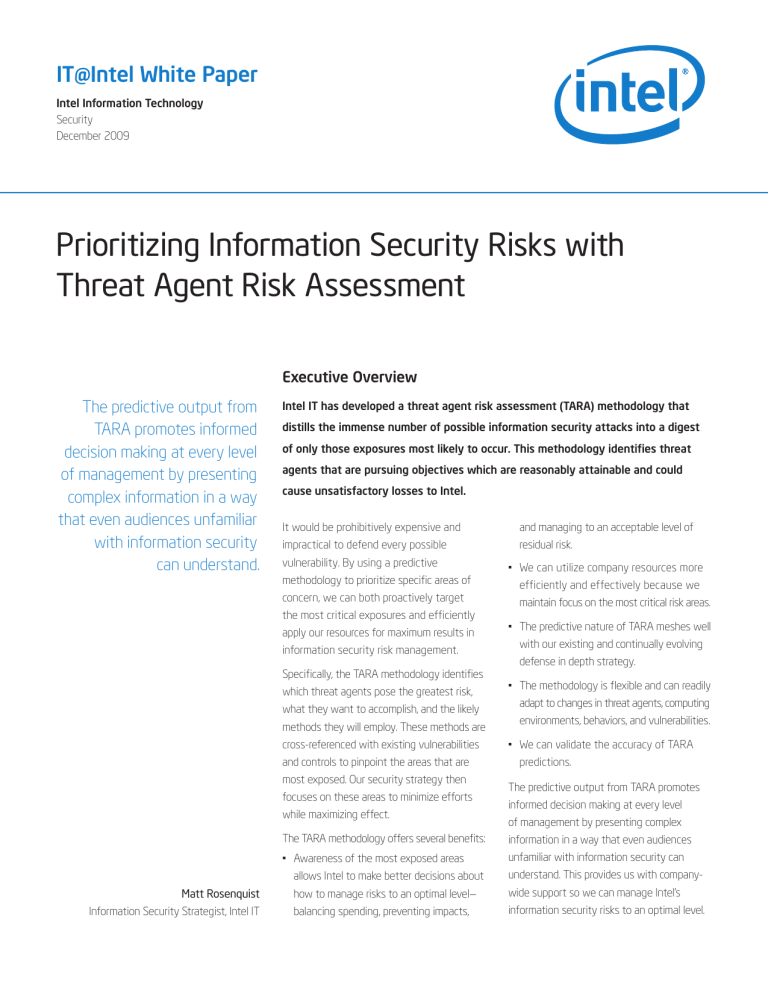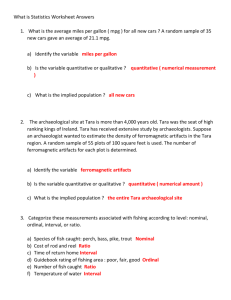
IT@Intel White Paper
Intel Information Technology
Security
December 2009
Prioritizing Information Security Risks with
Threat Agent Risk Assessment
Executive Overview
The predictive output from
TARA promotes informed
decision making at every level
of management by presenting
complex information in a way
that even audiences unfamiliar
with information security
can understand.
Intel IT has developed a threat agent risk assessment (TARA) methodology that
distills the immense number of possible information security attacks into a digest
of only those exposures most likely to occur. This methodology identifies threat
agents that are pursuing objectives which are reasonably attainable and could
cause unsatisfactory losses to Intel.
It would be prohibitively expensive and
and managing to an acceptable level of
impractical to defend every possible
residual risk.
vulnerability. By using a predictive
methodology to prioritize specific areas of
concern, we can both proactively target
the most critical exposures and efficiently
apply our resources for maximum results in
information security risk management.
Specifically, the TARA methodology identifies
which threat agents pose the greatest risk,
what they want to accomplish, and the likely
methods they will employ. These methods are
cross-referenced with existing vulnerabilities
and controls to pinpoint the areas that are
most exposed. Our security strategy then
focuses on these areas to minimize efforts
while maximizing effect.
Matt Rosenquist
Information Security Strategist, Intel IT
• We can utilize company resources more
efficiently and effectively because we
maintain focus on the most critical risk areas.
• The predictive nature of TARA meshes well
with our existing and continually evolving
defense in depth strategy.
• The methodology is flexible and can readily
adapt to changes in threat agents, computing
environments, behaviors, and vulnerabilities.
• We can validate the accuracy of TARA
predictions.
The predictive output from TARA promotes
informed decision making at every level
of management by presenting complex
The TARA methodology offers several benefits:
information in a way that even audiences
• Awareness of the most exposed areas
unfamiliar with information security can
allows Intel to make better decisions about
understand. This provides us with company-
how to manage risks to an optimal level—
wide support so we can manage Intel’s
balancing spending, preventing impacts,
information security risks to an optimal level.
IT@Intel White Paper Prioritizing Information Security Risks with Threat Agent Risk Assessment
Contents
Terms to Know
Executive Overview............................. 1
The following terms are used throughout this paper:
Background. ........................................... 2
VulnerabilityPart of the information security infrastructure that could
represent a weakness to attack in the absence of a control.
Threat Agent Risk Assessment. ...... 3
TARA Components............................ 4
Threat AgentPerson who originates attacks, either with malice or by
accident, taking advantage of vulnerabilities to create loss.
The TARA Process in Detail............. 5
MotivationInternal reason a threat agent wants to attack.
Results................................................. 6
Conclusion. ............................................. 8
Acronyms................................................ 8
Objective
What the threat agent hopes to accomplish by the attack.
MethodProcess by which a threat agent attempts to exploit a
vulnerability to achieve an objective.
Attack
Action of a threat agent to exploit a vulnerability.
ControlTools, processes, and measures put in place to reduce the risk
of loss due to a vulnerability.
Exposure
Vulnerability without a control.
BACKGROUND
At Intel, information security is an
important aspect of corporate risk
management. It would be prohibitively
expensive and impractical to protect
the enterprise against every
vulnerability, because information
security attacks come in many forms,
IT@INTEL
IT@Intel is a resource that enables IT
professionals, managers, and executives
to engage with peers in the Intel IT
organization—and with thousands of
other industry IT leaders—so you can
gain insights into the tools, methods,
strategies, and best practices that are
proving most successful in addressing
today’s tough IT challenges. Visit us
today at www.intel.com/IT or contact
your local Intel representative if you’d
like to learn more.
2 www.intel.com/IT
everything” becomes more costly while
losing effectiveness—as soon as one hole
is patched, two new holes appear. The
information security industry has been
searching for a rational method to narrow
threats in a practical manner that can be
applied to strategy, tactics, prioritization,
and resource management.
and attackers constantly evolve new
Intel IT has developed a sophisticated approach
tactics as we develop new defenses
to information security, our defense-in-depth
and controls. We need a way to identify
strategy1, which optimizes security using
the most likely attack vectors to
interlocking prediction, prevention, detection,
support the development of optimal
and response capabilities. As part of our
security strategies.
prediction capability, we have crafted a
standardized threat agent library (TAL) that
Early information security efforts in the IT
provides a consistent, up-to-date reference
industry concentrated on specific controls
describing the human agents that pose threats
such as firewalls, virus scans, authentication
to IT systems and other information assets.
and logon credentials, intrusion detection
and prevention packages, and cryptography.
These are important controls but are not
easily sustainable as they rely on closing
all emerging vulnerabilities. As the number
Determining which types of attacks are
possible is only the first step. The true value
derives from knowing which attacks are most
likely to occur.
of new vulnerabilities discovered each
year has skyrocketed, this model of “fixing
1 See “Defense in Depth Strategy Optimizes Security,”
Intel Corporation, September 2008.
Prioritizing Information Security Risks with Threat Agent Risk Assessment
IT@Intel White Paper
Defense in Depth Information Security Strategy
+
Attack
Response
Containment, cleaning, data recovery, and system restoration
Costs
Detect
Monitoring, detection, and immediate interdiction
Prevent
Barriers to inhibit or prevent attacks
Predict
Anticipate
–
–
Time
Threat Agent Risk Assessment
(TARA) Methodology
+
Figure 1. The threat agent risk assessment (TARA) methodology fits into the predict phase of our defense in depth information security strategy.
THREAT AGENT RISK
ASSESSMENT
Nor is TARA a forensics tool for investigating
capabilities, resources, intent, and access.
specific incidents after they occur. Rather,
For example, intent may be malicious or non-
TARA is a planning tool we use when we first
malicious. As the figure shows, threat agents are
Just because a vulnerability is a possible
start to consider risks in a certain area. TARA
the origin of risks. A threat agent’s motivations,
target doesn’t mean it is a probable one.
methodology is part of our overall defense in
capabilities, and objectives then map to likely
Threat agent risk assessment (TARA)
depth strategy, as shown in Figure 1.
methods. When a likely method intersects a
identifies the most likely attack vectors
to support the development of optimal
security strategies. TARA analysis
enables us to pinpoint the information
security areas of greatest concern—
TARA methodology is substantially different
from vulnerability assessments. Vulnerability
assessments attempt to identify every single
weak point—but since virtually anything could
vulnerability without controls, the result is an
area of exposure. These resulting exposures,
taking impacts into consideration, represent the
most critical and high-priority areas of concern.
be a weak point depending on the attacker,
In addition to identifying the mostly likely
methods, and objectives, vulnerability
exposures, TARA also takes into consideration
assessments can never be comprehensive.
acceptable levels of corporate risk. For example,
These higher-priority areas are characterized
Vulnerabilities are dangerous only if someone
if a successful attack is likely but poses very
by the existence of threat agents who
is interested in exploiting them and has the
little potential for loss or damage, TARA does
have the motivation and capabilities to take
means to do it. TARA concentrates on threat
not identify it as a high-priority exposure.
advantage of likely methods that will lead
agents and their motivations, methods, and
them to their objectives—and will in turn
objectives, and how they map to existing
cause unacceptable losses to Intel.
controls, not on the weak points themselves.
TARA methodology applies specifically
Figure 2 provides an overview of TARA
in information security. This enables various
to information security. We do not use it
methodology. Threat agents are attackers
levels of management to understand which
to predict the likelihood of other sorts of
who represent a security risk of loss, and they
information security risks are important, so
security risks such as theft of tangible goods.
are classified by characteristics including skills,
those which pose the highest level of
overall risk.
The results of TARA analysis delineate the
risks of greatest concern clearly, even to
audiences who have little or no background
www.intel.com/IT 3
IT@Intel White Paper Prioritizing Information Security Risks with Threat Agent Risk Assessment
All possible threats,
objectives, and methods
Attacker
Attacker
Threat
Objectives
Objectives
Agents
Attacker
Attacker
Attack
Objectives
Objectives
Methods
they can feed the results into a defense in
of real people; individuals may vary in degree
depth strategy. This strategy includes:
of hostility from the model, for example.
• Control maps outlining specific
preventative plans.
Attacker
Attacker
Attacker
Objectives
Objectives
Objectives
Filter and Prioritize
Highest risk threats,
objectives, and methods
• Tactical monitoring plans to focus on
likely successful attack vectors.
• Agent characterization in support of
direct interdiction.
COMMON EXPOSURE LIBRARY
For the first application of the TARA
methodology, we created our own CEL,
which enumerates known information
security vulnerabilities and exposures
at Intel. There are also several publicly
• Response plans to reduce specific impacts.
available CELs that provided additional
data for ours.
Vulnerabilities
Vulnerabilities without
controls for these attacks
are likely exposures
TARA Components
The CEL maps our vulnerabilities against
The TARA methodology relies on three main
existing controls to show which exposures
references to reach its predictive conclusions:
are residual. For example, because we have
• Threat agent library (TAL)
an antivirus solution installed on corporate
2
• Common exposure library (CEL)
• Methods and objectives library (MOL)
Controls
Exposures
laptop PCs, currently known viruses do not
represent an overt exposure. However, if
an unknown virus appears before we have
Standard frameworks such as these help
updated the antivirus solution, then an
ensure consistency and comprehensiveness
appreciable residual exposure exists.
when different risk assessors apply TARA
Areas of highest exposure
Figure 2. The threat agent risk assessment (TARA)
methodology narrows the field of all possible
attacks to determine the most likely attacks.
methodology to different environments.
METHODS AND OBJECTIVES LIBRARY
The third component of TARA, the MOL, lists
THREAT AGENT LIBRARY
known threat agent objectives—what they
The primary premise of the TARA methodology
want to accomplish—and the most likely
is that threat agents are the source of
methods they will employ to reach these
information security losses. Previously, Intel
objectives. These methods and objectives
developed the TAL to simplify the character
are cross-referenced with our defense-in-
set of all possible threat agents. It was
depth controls, such as firewalls, proxies,
therefore a natural choice to use it with
secure device configurations, and a security-
the TARA methodology.
aware workforce. Table 1 shows a sample
The Intel TAL defines eight common threat
subset of our MOL.
agent attributes, such as intent—hostile or
When the MOL is coupled with the TAL, a
non-hostile—and access—internal or external.
picture begins to emerge of the types of likely
Based on unique combinations of these
possible attacks, based upon many factors
attributes, the TAL identifies 22 unique
such as resources, objectives, typical methods,
threat agent archetypes, such as disgruntled
and preferred vulnerabilities. Additionally, an
employee, competitor, and organized crime.
estimate of consequences begins to form.
It is important to remember that the TAL
When the CEL is overlaid on this picture, those
provides archetypes, not exact descriptions
vulnerabilities with sufficient controls aligned
to reduce risk are dropped, and the remaining
2 See “Threat Agent Library Helps Identify Information
Security Risks,” Intel Corporation, September 2007.
4 www.intel.com/IT
vectors of attack emerge as the areas of
highest exposure.
Prioritizing Information Security Risks with Threat Agent Risk Assessment
IT@Intel White Paper
Table 1. Sample from Methods and Objectives (MOL) Library
METHOD
Accidental/Mistake
No malicious intent, accidental
X
X
X
Competitor
External
X
Personal Gain (Financial)
Obtain Business or Technical Advantage
X
Radical Activist
External
X
Social/Moral Gain
Change Public Opinion or Corporate Policy
X X
X
X X
Data Miner
External
X
Personal Gain (Financial)
Obtain Business or Technical Advantage
X
Vandal
External
X
Personal Gain (Emotional)
Personal Recognition or Satisfaction
Disgruntled Employee
Internal
Copy, Expose
Damage or Destroy Organization
Degradation of Reputation,
Image, or Brand
X
Legal or Regulatory Exposure
Internal
X
Loss of Competitive
Advantage, Market Share
Information Partner
X
X X
X
X
X
X X
X
X
X
X X
X
X
X
Business Operations Impact
X
Loss of Financial Assets
X
X
Crimes Against People
X
X
Take, Remove
X
No malicious intent, accidental
Administrator
No malicious intent, accidental
X X X Accidental/Mistake
Employee
X X X Accidental/Mistake
Internal
Partial Trust
Internal
Reckless Employee
None
Damage, Alter
Limits
Employee Error
X X X Personal Gain (Emotional)
IMPACT
Acts
Crimes Against Property
Goal
Destroy, Delete,
Render Unavailable
Motivation
Legal
OBJECTIVE
Trust
Code of Conduct
ATTACKER
Access
Deny, Withhold, Ransom
AGENT NAME
X
X
X
X
X
X
X
X
X
X
X
X
X
X
X
X
X
X
X
The TARA Process in Detail
motivations and threat agent capabilities.
To find the critical areas of exposure, the
Using the MOL, we derive the primary
OBJECTIVE
EXAMPLE
motivations and objectives of those
Theft/Exposure
Exposure of data resulting in loss
of competitive advantage, including
loss of intellectual property and
personal data.
Data Loss
Destruction or alteration of data—
including corruption, tampering,
denial of access, and deletion—so
it is not usable or it loses value.
Sabotage
Willful and persistent attempt
to cause disruption and damage,
including destruction of systems,
capabilities, processes, designs,
and brand.
Operations
Impact
Negative impact on business
operations, including manufacturing,
research, and engineering.
Embarrassment
Embarrassment targeted at
individuals or the corporation,
including real and fabricated
defamation, reputation poisoning,
and harassment targeting specific
personnel or the corporation.
TARA methodology uses six steps.
1. Measure current threat agent risks
to Intel. Using the TAL, a panel of senior
Intel experts regularly reviews and
ranks the current threat levels at Intel.
This is a qualitative to quantitative
exercise necessary to establish a
general understanding of current risks,
and it creates a baseline for future
TARA exercises.
2. Distinguish threat agents that exceed
baseline acceptable risks. Again using
the TAL, we measure new threat levels if
we’re starting a new project, or we create
an acceptable risk baseline if we don’t
think the current baseline is sufficient.
At the end of steps 1 and 2, we have
identified the threat agents that exceed
the current or new baseline threat level
for the areas being evaluated.
3. Derive primary objectives of those
threat agents. TARA defines objectives
as the combination of threat agent
Table 2. Examples of Threat Agent Objectives
threat agents identified in steps 1 and 2.
Motivations are important because they
underpin action, and they contribute to
factors such as the attacker’s commitment,
the point at which attacker will cease
pursuit, and the attacker’s susceptibility to
targets of opportunity. Table 2 lists some
examples of threat agent objectives.
4. Identify methods likely to manifest.
Again using the MOL, we identify the likely
methods by which an attack may occur.
TARA defines a method as a combination
of threat agent objectives and threat
agent operating methods. TARA identifies
the type of impact we could expect based
on motivations and objectives.
5. Determine the most important
collective exposures. Using the CEL, the
methodology first finds attack vectors,
which are vulnerabilities without controls.
Then, the intersection of the methods
determined in step 4 and the attack
vectors define likely exposures. Finally,
www.intel.com/IT 5
IT@Intel White Paper Prioritizing Information Security Risks with Threat Agent Risk Assessment
these likely exposures are ranked according
1
2
to their severity of consequence. The
Measure
current threat agent
risks to Intel
end result of step 5 is a list of the most
important collective exposures.
6. Align strategy to target the most
significant exposures. An assessment
Distinguish threat agents
that exceed baseline
acceptable risks
is worthless if it does not reinforce
the decision-making process. Analysts
and management can use the results
3
of TARA analysis to concentrate their
information security strategy on the
Derive primary objectives
of those threat agents
most important areas of concern and
allocate information security resources
in the most effective manner.
4
Figure 3 shows these steps in action,
Identify methods
likely to manifest
including a sample of TARA output at
each stage. As the figure illustrates, the
output uses graphs and tables to clearly
5
6
communicate the areas of greatest
Determine the
most important
collective exposures
Align strategy
to target the most
significant exposures
Exposures
3
2
1
information security risk.
Results
Figure 4 shows one hypothetical example of
the type of risk assessment data TARA can
Controls
provide when assessing information security
risks associated with a particular project. The
very center of the diagram represents low
Figure 3. By identifying the most important threat agents, objectives, and methods, the threat agent
risk assessment (TARA) methodology can help align our information security strategy to the most
critical exposures.
risk, and the risk level increases toward the
outer rim of the circle. The light blue area
Department of Homeland Security Adopts Intel’s Threat Agent Library
In May 2007, the U.S. Department of Homeland Security (DHS) published the Information Technology Sector-Specific Plan,
which provides guidance on how public and private entities will work together to protect IT infrastructure in the United States.
In August 2009, the DHS and the Information Technology Sector Coordinating Council released the IT Sector Baseline Risk
Assessment (ITSRA) to identify and prioritize national-level risks to critical, sector-wide IT functions while outlining strategies
to mitigate those risks and enhance national and economic security.
The ITSRA, which incorporates Intel’s threat agent library (TAL) as the foundation of its methodology, validates the resiliency
of key elements of U.S. IT infrastructure while providing a process by which public- and private-sector owners and operators
can continually update their risk management programs. The assessment links security measures to concrete data to provide
a basis for meaningful infrastructure protection metrics.
For more information on the ITSRA, visit www.dhs.gov/xlibrary/assets/nipp_it_baseline_risk_assessment.pdf.
6 www.intel.com/IT
IT@Intel White Paper
Prioritizing Information Security Risks with Threat Agent Risk Assessment
represents default risks; these risks existed
operations, including our supply network,
Confidence in any risk assessment methodology
before the project began. In some situations
high-speed manufacturing, product design
is based upon its accuracy. TARA is predictive
they may represent accepted risks per
engineering, product assembly and test,
in nature and outlines the likely attacks and
company policy. The dark blue areas show
enterprise applications, and IT systems.
consequences. If we establish controls to
the elevated risks associated with the project.
For example, in Figure 4, “irrational individuals”
do not present a major threat during this
reduce the risk of a successful attack, the
During this project, corporate policy and
consequences may not actually occur. However,
normal controls managed the default risks;
the attack attempts can be apparent, and we
using the TARA results, we could focus
project, while “disgruntled employees” are
can track them. Evaluating the predicted likely
on the risks specific to the nature of the
one of the highest risks.
attack vectors against what actually occurs is
project. To derive the highest priority residual
We tested and successfully applied TARA
exposures, we overlaid the areas of concern
methodology to a very large project, which
from the TARA analysis against existing
we then studied to determine TARA’s
information security controls, and we were
effectiveness. This project posed direct
able to develop an overall information
significant risks to many areas of Intel
security strategy for the project.
one way to measure relative accuracy. In our
case study, as the project progressed over two
years, the areas of concern highlighted by the
TARA analysis proved to be accurate predictors
of likely attack vectors.
Hypothetical Example of Risk Comparison for
Threat Agent Profiles
Project Risk
Default Risk
Disgruntled Employee
Competitor
Data Miner
High Risk
Information Partner
Radical Activist
Untrained Employee
Cyber Vandal
Civil Activist
Reckless Employee
Government Cyber Warrior
Vendor
Low Risk
Organized Criminal
Thief
Corrupt Government Official
Government Spy
Terrorist
Internal Spy
Legal Adversary
Irrational Individual
Anarchist
Sensationalist
Figure 4. The threat agent risk assessment (TARA) methodology provides information on project-specific information security risks, which may differ from
an organization’s default level of information security risks.
www.intel.com/IT 7
CONCLUSION
• Rational. TARA’s predictive results can be
TARA is a new direction in information security
risk assessment. It distills an overwhelming
validated over time and provide support for
ACRONYMS
trend analysis and risk exposure snapshots.
CEL
risk landscape to the most likely risks, so an
These characteristics contribute to TARA’s
organization can properly align resources
major strengths, which include:
and intelligently develop an ongoing security
strategy.
that make it attractive to managers who may
representing the areas of greatest
view information security as too complex and
information security concern.
levels. Even audiences unfamiliar with
likely to occur, thereby reducing the
information security can understand
threat surface we must protect, and
the results of a TARA analysis, because
communicates this information in an
TARA’s filtering methodology reduces
easy-to-understand format.
complex, seemingly chaotic data to
• Cross-referenced with controls to show
the true level of exposure.
attacker objectives.
• Takes into account acceptable risk levels.
• The ability to validate its predictive results
and external; malicious and non-malicious;
and direct and indirect.
over time.
By adapting to the constantly changing
• Scalable. TARA methodology is applicable
landscape of threat agents, objectives, and
to any size organization at any level of
methods, TARA allows us to make better
complexity.
decisions on how to manage information
• Practical. TARA methodology can be
security risks at an optimal level, properly
as quick and simple or as deliberate and
allocating resources and balancing spending
complex as needed.
against prevented losses.
For more straight talk on current topics from Intel’s IT leaders,
visit www.intel.com/it.
This paper is for informational purposes only. THIS DOCUMENT IS
PROVIDED “AS IS” WITH NO WARRANTIES WHATSOEVER, INCLUDING
ANY WARRANTY OF MERCHANTABILITY, NONINFRINGEMENT, FITNESS
FOR ANY PARTICULAR PURPOSE, OR ANY WARRANTY OTHERWISE
ARISING OUT OF ANY PROPOSAL, SPECIFICATION OR SAMPLE. Intel
disclaims all liability, including liability for infringement of any proprietary
rights, relating to use of information in this specification. No license, express
or implied, by estoppel or otherwise, to any intellectual property rights is
granted herein.
Intel and the Intel logo are trademarks of Intel Corporation in the U.S. and
other countries.
* Other names and brands may be claimed as the property of others.
Copyright © 2009 Intel Corporation. All rights reserved.
Printed in USA
1209/JLG/KC/PDF
threat agent library
TARAthreat agent risk assessment
something more manageable.
• Adaptive. TARA can adjust to changes
of security incidents, including internal
TAL
analysis results across management
of threat vectors to those most
• Comprehensive. TARA covers all types
MOLmethods and objectives
library
• The ability to effectively communicate
• Sensible. TARA narrows the number
in threat agents, attack methods, and
ITSRAIT Sector Baseline Risk
Assessment
most important risks, and then summarize
them into a narrow set of likely attacks
complicated:
DHSDepartment of Homeland
Security
• The ability to analyze and prioritize the
TARA methodology has several characteristics
common exposure library
Please Recycle
322696-001US










